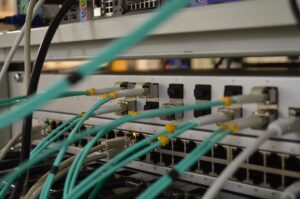Covid-19 has accelerated the rate of digital transformation like nothing the world has ever seen before. In this piece, Song Toh, VP of Global Network Services, Tata Communications, explores how enterprises can develop a new approach to networks that caters for their specific needs.
Over the past few years, there has been a dramatic increase in the digital transformation of businesses across industries. And as a result, the network infrastructure of organisations has also changed significantly.
Previously data centres were the centre of gravity of an enterprise network, but as businesses moved to the cloud, the networks started to evolve. 
Covid-19 acted as the catalyst and further accelerated this transformation. As workforce mobility grows, the adoption of connected devices and data-driven digital platforms continues to increase, further expanding the migration of application workloads to the cloud along with it.
The acceleration of demand
No one could have predicted how Covid-19 would turn the business world upside down this year. Much of the network architecture companies had implemented, connecting their offices and workplaces to the cloud through centralised infrastructure, has been undone by the pivot to distributed workforce.
Where users would once access applications and information from company offices, they now need to connect from anywhere in the world.
“IT organisations and their corresponding networks are finding it harder to efficiently manage how, where and who has access of data and applications, and in what way.”
Traditional networks are nowhere near agile enough to cope with the recent surge in demand. In the past, these legacy systems could cope when limited number of people (typically fewer than 30% for knowledge workers), who decided to work from home at a certain time, were trying to connect to the VPN. Now the case is completely different.
 Fundamentally the current state of play does not make sense – why, with the majority of a workforce working from home, should everyone connect to their office and then to the cloud?
Fundamentally the current state of play does not make sense – why, with the majority of a workforce working from home, should everyone connect to their office and then to the cloud?
I believe the deployment of agile SD-WAN or zero-trust clients on devices for users to work from home will be one of the next big steps for global network infrastructure.
SD-WAN enables standardisation and automation of network infrastructure, is quicker to update multiple sites, and provides added security – meaning less need for separate firewall appliances.
All of which ultimately increases application performance and delivers a high-quality user experience across the network, enabling enterprises and their distributed workforce to access documents and apps securely and with an enterprise-grade experience – from anywhere, anytime.
However, businesses must understand that SD-WAN is not just a quick fix on top of their existing not-fit-for-purpose networks.
A business looking to future-proof their infrastructure should anticipate and can evolve with long-term business objectives, needs and limitations as well as predicted technology developments.
A “new normal” for networks
“Our old working patterns, workspaces, and settings will not return even as we tackle the pandemic globally. Now enterprises are looking to build networks that aren’t based on their office buildings but built around their teams and users.”
Networks need to serve enterprise users’ digital transformation at the speed that the current situation dictates. Solutions such as Network Function Virtualisation (NFV) can be used to build these user-centric networks that reflect the pace and agility of SaaS and our new distributed workplaces.
NFV allows enterprises to “virtualise” or run their network’s functions in the cloud. In addition, it allows enterprises to subscribe to network services at their office premises, in the cloud or service provider edge.
They can even modify their architecture by redeploying these functions to another location. This ad-hoc, agile approach reduces operational costs and allows businesses to modify their IT architecture without having to move hardware.
The invisible door to business transformation
The promise of automation and virtualisation with SD-WAN and NFV is so vast that soon an enterprise’s network will be the ladder to the success of their digital transformation strategy.
“For all their blueprints and plans for successful implementation, if businesses don’t put together a network that is ready to enable them, the vision to operate as a digital business would be hard to realise.”
Businesses must realise that their networks aren’t just a flat superhighway that everyone and everything can jump on to. Given the vast complexity of new hybrid networks that integrate SDN, SD-WAN and NFV, it is no longer viable for everything to just connect to everything else. 
What businesses need now is an intelligent platform, that understands the interactions between the digital aspects of a business.
Networks should be seen almost as employees by organisations. Just as leaders understand the strengths and weaknesses of their teams and utilise their skills on projects where they can excel, so too must businesses tailor their new network approach to their specific needs as an enterprise.
Ultimately when it comes to enterprise networks there is a need for speed, one that is leaving legacy networks and MPLS in its dust.
Discover more about how businesses can transform the network for greater agility and security.
Transformational Hybrid SolutionsOur cloud-enablement services offer the best performance on your traffic-heavy websites or mission-critical applications.
Core NetworksTata Communications™ global IT infrastructure and fibre network delivers the resources you need, when and where you need them.
Network Resources
Unified Communications As A ServiceBreak the barriers of borders efficiently and increase productivity with Tata Communications’ UC&C solutions.
Global SIP ConnectEmpower your business with our SIP network and witness it grow exponentially.
InstaCC™ - Contact Centre As A ServiceCloud contact centre solutions for digital customers experience and agent productivity.
Unified Communication Resources Case studies, industry papers and other interesting content to help you explore our unified communications solution better.
IoT SolutionsThe Internet of Things is transforming the way we experience the world around us for good. Find out more about our Internet Of Things related solutions here.
Mobility SolutionsTata Communications’ mobility services enable your enterprise to maintain seamless communication across borders, with complete visibility of cost and usage.
Mobility & IoT Resources
Multi-Cloud SolutionsWith enterprises transitioning to a hybrid multi-cloud infrastructure, getting the right deployment model that yields ROI can be a daunting task.
Cloud ComplianceCompliant with data privacy standards across different countries and is also designed to protect customers’ privacy at all levels.
IZO™ Cloud Platform & ServicesIZO™ is a flexible, one-stop cloud enablement platform designed to help you navigate complexity for more agile business performance.
Managed Infrastructure ServicesIntegrated with our integrated Tier-1 network to help your business grow efficiently across borders.
Cloud PartnersWe support a global ecosystem for seamless, secure connectivity to multiple solutions through a single provider.
Cloud Resources
Governance, Risk, and ComplianceRisk and Threat management services to reduce security thefts across your business and improve overall efficiencies and costs.
Cloud SecurityBest-in-class security by our global secure web gateway helps provide visibility and control of users inside and outside the office.
Threat Management - SOCIndustry-leading threat-management service to minimise risk, with an efficient global solution against emerging security breaches and attacks.
Advanced Network SecurityManaged security services for a predictive and proactive range of solutions, driving visibility and context to prevent attacks.
Cyber Security ResourcesCase studies, industry papers and other interesting content to help you explore our securtiy solution better.
Hosted & Managed ServicesTata Communications provide new models for efficient wholesale carrier voice service management. With our managed hosting services make your voice business more efficient and better protected
Wholesale Voice Transport & Termination ServicesYour long-distance international voice traffic is in good hands. End-to-end, voice access & carrier services which includes voice transport and termination with a trusted, global partner.
Voice Access ServicesTata Communication’s provide solutions which take care of your carrier & voice services, from conferencing to call centre or business support applications.
Carrier Services Resources
CDN Acceleration ServicesOur CDN Web Site Acceleration (WSA) solution helps deliver static and dynamic content, guaranteeing higher performance for your website.
CDN SecuritySafeguard your website data and customers’ information by securing your website from hacks and other mala fide cyber activities.
Video CDNDeliver high-quality video content to your customers across platforms – website, app and OTT delivery.
CDN Resources
Elevate CXIncrease customer satisfaction while empowering your service team to deliver world-class customer experience and engagement.
Live Event ServicesTata Communications’ live event services help battle the share if eyeballs as on-demand video drives an explosion of diverse content available on tap for a global audience.
Media Cloud Infrastructure ServicesTata Communications’ media cloud infrastructure offers flexible storage & compute services to build custom media applications.
Global Media NetworkTata Communications’ global media network combines our expertise as a global tier-1 connectivity provider with our end-to-end media ecosystem.
Use CasesUse cases of Tata Communications’ Media Entertainment Services
Remote Production SolutionsMedia contribution, preparation and distribution are highly capital-intensive for producers of live TV and video content, and their workflows are complex.
Media Cloud Ecosystem SolutionsThe Tata Communications media cloud infrastructure services offer the basic building blocks for a cloud infrastructure-as-a-service.
Global Contribution & Distribution SolutionsTata Communications’ global contribution and distribution solution is built to reduce capital outlay and grow global footprint.
Satellite Alternative SolutionsAs more and more consumers choose to cut the cord & switch to internet-based entertainment options, broadcasters are faced with capital allocation decisions.
LeadershipA look into the pillars of Tata communications who carry the torch and are living embodiment of Tata’s values and ethos.
Culture & DiversityHere at Tata Communications we are committed to creating a culture of openness, curiosity and learning. We also believe in driving an extra mile to recognize new talent and cultivate skills.
OfficesA list of Tata Communications office locations worldwide.
FAQCheck out our FAQs section for more information.
SustainabilityOur holistic sustainability strategy is grounded in the pillars of People, Planet and Community with corporate governance at the heart of it.
BoardHave a look at our board of members.
ResultsFind out more about our quarterly results.
Investor PresentationsFollow our repository of investor presentations.
FilingsGet all information regarding filings of Tata communications in one place.
Investor EventsAll investor related event schedule and information at one place.
GovernanceAt Tata, we believe in following our corporate social responsibility which is why we have set up a team for corporate governance.
SharesGet a better understanding of our shares, dividends etc.
SupportGet all investor related contact information here.


